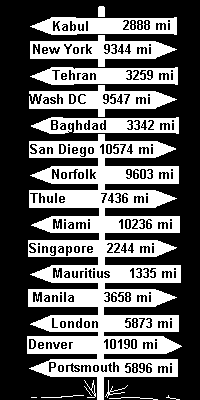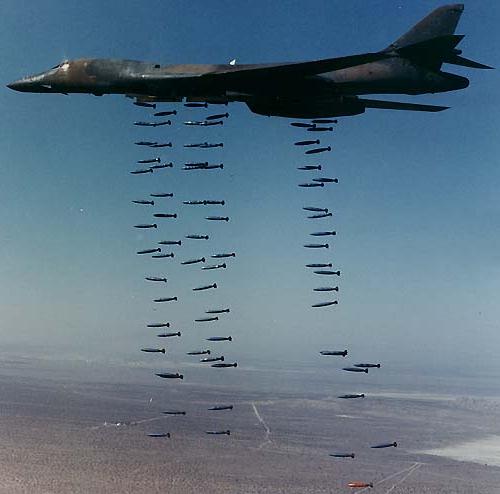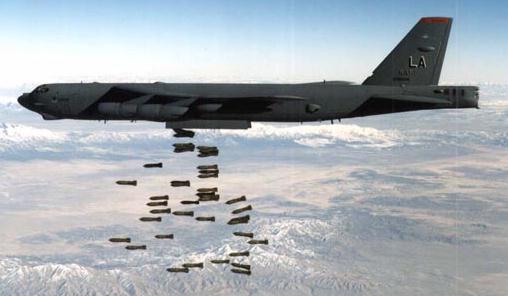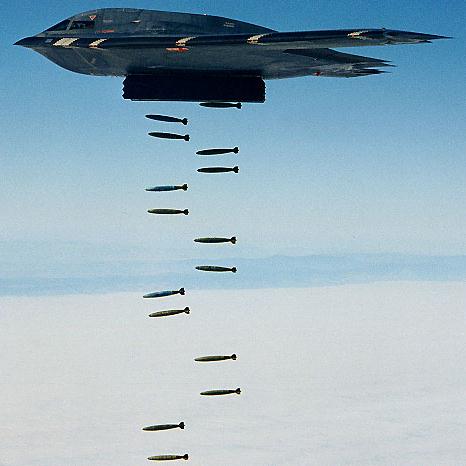Just in case you do need it
spelled out...
On 16 November 2004 Mr Lincoln P. Bloomfield,
Jr the US Assistant Secretary of State for
Political-Military Affairs wrote the following letter to
Mr Robert N. Culshaw, the Director of the Americas and
Overseas Territories, UK Foreign and Commonwealth
Office:
The discussions that you and our respective
colleagues have had over the past several months have
included consideration of issues related to joint
facilities on Diego Garcia in Chagos Archipelago. The
considerations explained in the letter of June 21, 2000,
from Eric Newsom, my predecessor as Assistant Secretary
of State for Political-Military Affairs, to your
predecessor have become even more cogent due to the
significant events transpiring after that letter was
written. The use of the facilities on Diego Garcia in
major military operations since September 11, 2001, has
reinforced the United States' interest in maintaining
secure long-term access to them. The United States has
an interest in preserving the security of the
Archipelago and in protecting Diego Garcia's strategic
value.
Diego Garcia is a vital and indispensable
platform for global U.S. military operations, as
demonstrated by the important role it played for U.S.
and coalition military forces in Operations Enduring
Freedom and Iraqi Freedom, as well as by its continuing
role in the Global War on Terrorism. The Chagos
Archipelago's geographic location, isolation and
uninhabited state make it unique among operating bases
throughout the world. Our governments' facilities on
Diego Garcia have exceptional security from armed
attack, intelligence collection, surveillance and
monitoring, and electronic jamming.
... A decline in Diego Garcia's military
utility would have serious consequences for our shared
defence interests ... I appreciate Her Majesty's
Government's sensitivity to our common defence and
security imperatives and look forward to continuing our
excellent cooperation on this matter.
Here is the aforementioned Mr. Newsom's letter
that spells out the U.S. position regarding the value of
Diego Garcia and the Chagos to our liberty:
United States Department of State
Assistant Secretary of State for
Political-Military Affairs
Washington, D.C. 20520
June 21, 2000
Mr. Richard D. Wilkinson, CVO
Director for Americas
Foreign and Commonwealth Office
London
United Kingdom
Dear Mr. Wilkinson:
I would like to take this opportunity to
express the United States Government’s serious concern
over the inevitable compromise to the current and future
strategic value of Diego Garcia that would result from
any move to settle a permanent resident population on
any of the islands of the Chagos archipelago.
Please let me provide some detail on our concerns and on
the strategic considerations on which they rest.
In carrying out our defense and security
responsibilities in the Arabian Gulf, the Middle East,
South Asia and East Africa, Diego Garcia represents for
us an all but indispensable platform. For this
reason, in addition to extensive naval requirements, the
USG is seeking the permission of your government to
develop the island as a forward operating location for
expeditionary air force operations — one of only four
such locations worldwide. These locations, to
which considerable funds have already been committed,
are intended to serve as primary staging points for
defense activities in key regions for quite some time to
come. We anticipate that our commitment of
resources to the island will grow in the years ahead in
order to develop the necessary infrastructure to
sustain, should it become necessary, intensified
military operations. Moreover, as resources for
defense diminish in other areas, the centrality of the
islands for ensuring U.S. and British security interests
will only increase.
In addition to its other facilities, Diego
Garcia currently is the home of Detachment 2, 22nd Space
Operations Squadron of the U.S. Air Force, which is the
newest of eight worldwide satellite command and control
stations that constitute the Air Force Satellite Control
Network. This Detachment is essential for launch,
operation, and in-orbit command, control, and mission
data recovery of over 110 U.S. Department of Defense and
other National and Civil Agency satellites that enhance
that capabilities of conventional forces of the U.S. and
allied nations. This Detachment also provides
support to NASA’s Space Shuttle and Goddard Spaceflight
Center, NATO and United Kingdom satellites.
In looking to the future strategic importance
of the Chagos archipelago, it is also worthwhile to
consider the central role the facility on Diego Garcia
has in recent years played in the defense activities and
military operations of our two governments. For
example, during Operation Earnest Will, which involved
protection of merchant shipping in the Persian Gulf
during the Iran-Iraq war, the U.S Air Force used Diego
Garcia as a staging site for a large number of supply
flights to the region by C-5 and C-141 aircraft from the
Military Airlift Command. In Operations Desert
Shield and Desert Storm, over 600 combat missions were
flown from the island, and facilities there housed over
2000 additional personnel required to support those
missions. During September and October of 1996,
B-52, KC-135 and KC-10 aircraft operated from Diego
Garcia in direct support of Operation Desert
Strike. In November 1997, B-52, KC-10 and KC-135
aircraft operated from Diego Garcia in support of
Operation Desert Thunder. In 1998, over 400
personnel reported to the Diego Garcia installation to
support B-52 and KC-10 aircraft operations in support of
Operation Desert Fox.
It has been suggested that military bases in
Europe function close to civilian population centers,
and hence the facilities on Diego Garcia could do so as
well. This assertion misses several points.
Diego Garcia’s desirability as a location for such
varied past and future military operations hinges on the
combination of its strategic location and isolation,
which is unique among operating locations around the
world. The settlement of a permanent civilian
population on the islands of the Chagos archipelago,
even those at some distance from Diego Garcia, would
seriously diminish that isolation and as a consequence
erode the island’s nearly unparalleled strategic
importance. If a resident population were
established on the Chagos archipelago, that could well
imperil Diego Garcia’s present advantage as a base from
which it is possible to conduct sensitive military
operations that are important for the security of both
our governments but that, for reasons of security,
cannot be staged from bases near population centers.
Settlements on the outer islands would also
immediately raise the alarming prospect of the
introduction of surveillance, monitoring and electronic
jamming devices that have the potential to disrupt,
compromise or place at risk vital military
operations. In or near population centers in
Western Europe or the United States, efforts by other
states or hostile organizations to introduce and employ
surveillance, monitoring and electronic jamming devices
close to a military base carry a considerable risk of
discovery, if only because of the large number of people
in the surrounding area. By contrast, the return
of small and scattered populations onto islands of the
archipelago would make introduction and use of such
devices possible with much less risk of discovery
because this would occur in an isolated and undeveloped
area. In this connection, we note that the largest
of the outer islands, the Peros Banos and Salomon
atolls, are located only about 140 miles north of Diego
Garcia — a location quite well-suited for monitoring
military movements from Diego Garcia in reaction to any
Persian Gulf or other contingency.
We have other serious concerns as well.
Introduction of settlements on the outer islands of the
archipelago would put facilities on Diego Garcia more
easily within potential reach of hostile states or
terrorists operating by boat. As you know, the
potential danger from such an attack on the 21
prepositioning ships located at Diego Garcia would be
very serious. For the first time in the history of
our military cooperation on Diego Garcia, significant
personnel and other assets would be required solely for
the purposes of protecting the forces, materials, and
facilities located there. Initiation of such
requirements on the island would, beyond the
considerable expense for both of our governments,
possibly entail reconfiguration of base facilities and
potential limitations on a number of activities and
operations.
In addition, in the event of hostilities
during which Diego Garcia and other islands of the
archipelago were attacked, the U.S. would not be
in a position to ensure the safety and welfare of any
resident civilian population on the outer islands.
At the same time, however, your Government’s need to
provide for their protection or rescue in these
circumstances could well require diversion of forces
from the island, complicating and possibly impeding
fulfillment of other critical missions.
Finally, the suggestion that commercial or
touristic projects on the outer islands could be
implemented and kept viable without ties to Diego
Garcia, its airport, and its other infrastructure and
services appears to us very questionable. It
strikes us as highly doubtful that the outer islands
could support a resident civilian population and be
developed economically without access to an
international airport. Use of the military
facility on Diego Garcia for this purpose, however,
cannot be contemplated.
Nor, in the unlikely event that an
international airport were built on one of the outer
islands to support limited touristic activities, could
the sensitive military facility at Diego Garcia serve as
a back-up airport. In this connection, you will
recollect that applicable agreements between our two
governments restrict civilian aircraft from using
military airfields in the Chagos archipelago, except in
exceptional circumstances and under such terms and
conditions as may be defined by the two
governments. Moreover, the medical, resupply, and
communications infrastructure on Diego Garcia would also
not be available for any touristic activities in the
outer islands or indeed for any of the other purposes of
a civilian population there. Yet the absence of
other practicable sources of back-up supplies and
services for the nearby civilian population is one of
the most telling factors distinguishing the situation of
the military facility on Diego Garcia from U.S. bases in
the United Kingdom.
In addition, it is important to consider the
impact of military requirements on the viability and
future of any settlement. The needs of naval
forces to operate through numerous and changing shipping
lanes could at any time conflict with plans to base a
settlement’s economy on fishing or tourism.
Furthermore, currently unforeseeable circumstances could
require the future use of the outer Chagos islands for
defense purposes. In considering the impact of
such a situation on a settlement, it is useful to recall
that the 1966 Exchange of Notes stipulates that the
islands of Diego Garcia and the remainder of the Chagos
archipelago shall be available to meet the defense needs
of both nations as they arise.
In sum, our view is that any settlement of a
resident civilian population even on the outer islands
of the archipelago would significantly degrade the
strategic importance of a vital military asset unique in
the region to both our governments. Such a step
would necessitate a serious reevaluation of current and
future U.S. defense plans involving the island as well
as U.S. strategic planning more generally. I
certainly hope this can be avoided.
In the spirit of the open and frank exchanges
that characterize relations between our two governments,
I very much appreciate this opportunity to lay out my
government’s views on this important issue. I and
my staff would be pleased to provide any additional
information you would find helpful and hope this matter
can be resolved in a mutually satisfactory manner.
With very best wishes,
Sincerely,
{Signature}
Eric Newsom







